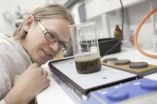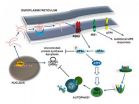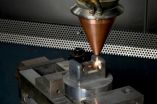(Press-News.org) Researchers at Aalto University have developed a simple method for reducing the amount of phosphorus in the wastewater of a pulp mill. The method is called simultaneous precipitation using iron sulphate. A separate treatment stage is not required, as the precipitation takes place simultaneously with the actual biological wastewater treatment.
Iron sulphate is added to the wastewater prior to the biological wastewater treatment process, and the phosphorus dissolved into the water is precipitated with the biomass at the treatment plant. Finally, the phosphorus is removed from the plant with the sludge. In Finland, sludge is generally burned, in which case the phosphorus would end up in the ashes and would thus be reusable in the form of fertilizers, for example.
At best, the amount of phosphorus in the wastewater was reduced by more than 80 per cent, when the amount of iron fed into the process was 10 milligrams per litre,' commented researcher Sakari Toivakainen, who is currently preparing his doctoral dissertation.
Simultaneous precipitation creates savings in wastewater treatment costs
Public authorities are calling for the lowering of phosphorus emissions. For this reason, many factories have adopted an additional post-treatment precipitation stage, which is usually implemented using aluminium.
Post-treatment precipitation using aluminium produces difficult-to-process sludge. On the whole, simultaneous precipitation would seem to be a more advantageous option, Timo Laukkanen, Doctor of Science (Technology), concludes.
Simultaneous precipitation does not require additional wastewater treatment units, so there is no need for additional energy in the treatment of the water, either. An additional benefit of the method is that iron sulphate is an inexpensive chemical. A municipal wastewater treatment plant in Saint Petersburg constructed a few years ago employs simultaneous precipitation, among other methods. The industry, on the other hand, is only just waking up to the possibility of applying simultaneous precipitation. Wastewater from the forestry industry contains less phosphorus than municipal wastewater, so the dosage of the iron chemical remains within reasonable limits.
Experiments at the pulp mill
Initially, the research was carried out in the laboratories of Otaniemi and at the plant using pilot equipment. The results were so promising that, later on; iron precipitation was also successfully tested at the wastewater treatment section of a pulp mill.
From the viewpoint of comprehensive environmental protection and sustainable development, the best method is always the one that saves energy and minimises the amount of waste. With the help of the studied simultaneous precipitation method, it is possible to completely avoid additional stages of wastewater treatment, reduce the amount of solid waste and save energy. Simultaneous precipitation produces hundreds of thousands of euros worth of savings in operating costs, as energy consumption and the need for additional chemicals is reduced, Professor Olli Dahl crystallises.
The research has been published in the Water Science & Technology journal.
INFORMATION:
Researchers identify a simple way to precipitate phosphorus from the wastewater of a pulp mill
2012-11-21
ELSE PRESS RELEASES FROM THIS DATE:
'Trust' provides answer to handaxe enigma
2012-11-21
Trust rather than lust is at the heart of the attention to detail and finely made form of handaxes from around 1.7 million years ago, according to a University of York researcher.
Dr Penny Spikins, from the Department of Archaeology, suggests a desire to prove their trustworthiness, rather than a need to demonstrate their physical fitness as a mate, was the driving force behind the fine crafting of handaxes by Homo erectus/ergaster in the Lower Palaeolithic period.
Dr Spikins said: "We sometimes imagine that early humans were self-centred, and if emotional at all, that ...
Ocean currents play a role in predicting extent of Arctic sea ice
2012-11-21
CAMBRIDGE, MA -- Each winter, wide swaths of the Arctic Ocean freeze to form sheets of sea ice that spread over millions of square miles. This ice acts as a massive sun visor for the Earth, reflecting solar radiation and shielding the planet from excessive warming.
The Arctic ice cover reaches its peak each year in mid-March, before shrinking with warmer spring temperatures. But over the last three decades, this winter ice cap has shrunk: Its annual maximum reached record lows, according to satellite observations, in 2007 and again in 2011.
Understanding the processes ...
Daily steps add up for midlife women's health
2012-11-21
CLEVELAND, Ohio (November 21, 2012)—Moving 6,000 or more steps a day—no matter how—adds up to a healthier life for midlife women. That level of physical activity decreases the risk of diabetes and metabolic syndrome (a diabetes precursor and a risk for cardiovascular disease), showed a study published online this month in Menopause, the journal of the North American Menopause Society.
Although other studies have shown the value of structured exercise in lowering health risks such as diabetes, high blood pressure, and heart disease, this study has shown that habitual physical ...
Brainy babies – Research explores infants' skills and abilities
2012-11-21
Infants seem to develop at an astoundingly rapid pace, learning new things and acquiring new skills every day. And research suggests that the abilities that infants demonstrate early on can shape the development of skills later in life, in childhood and beyond.
Read about the latest research on infant development published in the November 2012 issue of Psychological Science, a journal of the Association for Psychological Science.
How Do You Learn to Walk? Thousands of Steps and Dozens of Falls per Day
How do babies learn to walk? In this study, psychological scientist ...
Short DNA strands in the genome may be key to understanding human cognition and diseases
2012-11-21
Short snippets of DNA found in human brain tissue provide new insight into human cognitive function and risk for developing certain neurological diseases, according to researchers from the Departments of Psychiatry and Neuroscience at Mount Sinai School of Medicine. The findings are published in the November 20th issue of PLoS Biology.
There are nearly 40 million positions in the human genome with DNA sequences that are different than those in non-human primates, making the task of learning which are important and which are inconsequential a challenge for scientists. ...
It takes two to tangle: Wistar scientists further unravel telomere biology
2012-11-21
Chromosomes - long, linear DNA molecules – are capped at their ends with special DNA structures called telomeres and an assortment of proteins, which together act as a protective sheath. Telomeres are maintained through the interactions between an enzyme, telomerase, and several accessory proteins. Researchers at The Wistar Institute have defined the structure of one of these critical proteins in yeast.
Understanding how telomeres keep chromosomes – and by extension, genomes – intact is an area of intense scientific focus in the fields of both aging and cancer. In aging, ...
Pathway identified in human lymphoma points way to new blood cancer treatments
2012-11-21
PHILADELPHIA – A pathway called the "Unfolded Protein Response," or UPR, a cell's way of responding to unfolded and misfolded proteins, helps tumor cells escape programmed cell death during the development of lymphoma.
Research, led by Lori Hart, Ph.D., research associate and Constantinos Koumenis, Ph.D., associate professor,and research division director in the Department of Radiation Oncology, both from the Perelman School of Medicine, University of Pennsylvania, and Davide Ruggero, Ph.D., associate professor, Department of Urology, University of California, San Francisco, ...
University of Tennessee study: Unexpected microbes fighting harmful greenhouse gas
2012-11-21
The environment has a more formidable opponent than carbon dioxide. Another greenhouse gas, nitrous oxide, is 300 times more potent and also destroys the ozone layer each time it is released into the atmosphere through agricultural practices, sewage treatment and fossil fuel combustion.
Luckily, nature has a larger army than previously thought combating this greenhouse gas—according to a study by Frank Loeffler, University of Tennessee, Knoxville–Oak Ridge National Laboratory Governor's Chair for Microbiology, and his colleagues.
The findings are published in the ...
Saving water without hurting peach production
2012-11-21
U.S. Department of Agriculture (USDA) scientists are helping peach growers make the most of dwindling water supplies in California's San Joaquin Valley.
Agricultural Research Service (ARS) scientist James E. Ayars at the San Joaquin Valley Agricultural Sciences Center in Parlier, Calif., has found a way to reduce the amount of water given post-harvest to early-season peaches so that the reduction has a minimal effect on yield and fruit quality. ARS is USDA's principal intramural scientific research agency, and the research supports the USDA priority of promoting international ...
Better protection for forging dies
2012-11-21
Forging dies must withstand a lot. They must be hard so that their surface does not get too worn out and is able to last through great changes in temperature and handle the impactful blows of the forge. However, the harder a material is, the more brittle it becomes - and forging dies are less able to handle the stress from the impact. For this reason, the manufacturers had to find a compromise between hardness and strength. One of the possibilities is to surround a semi-hard, strong material with a hard layer. The problem is that the layer rests on the softer material and ...


